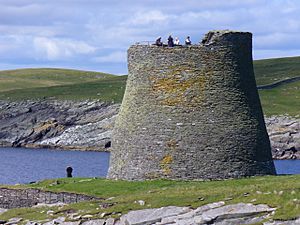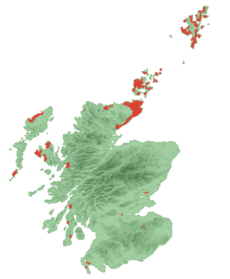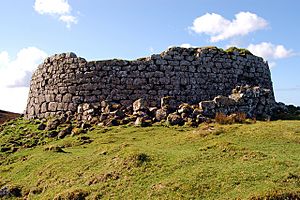Broch facts for kids
A broch (say "brok") is a special kind of ancient building found in Scotland. These tall, round towers were built during the Iron Age, which was about 2,000 years ago. They are made of stone without any mortar, like a giant drystone wall.
Brochs are found all over Scotland, especially in the north and on the islands. The word "broch" comes from an old Scottish word meaning "fort." People in the past also called them "burgs" or "duns," which also mean fort. Brochs are some of the most amazing ancient buildings in northern Scotland. Experts have found about 571 places where brochs might have stood.
For a long time, people wondered where brochs came from. Some thought they were built by people who moved to Scotland. But now, most experts believe that the idea for these hollow-walled towers was invented right there in Scotland. The first brochs were likely built around 100 BC. People think they were used for protection, either to defend against attacks or to launch them.
Contents
What is a Broch?
The word broch comes from an old Scottish word, 'brough', which means fort. In the 1800s, people studying old things in Scotland called them 'burgs'. This word came from an old Norse word, borg, which also means fort. In some parts of western Scotland, brochs are still called duns. The name broch became popular in the 1870s.
It's hard to give a perfect definition for a broch because they are quite unique. They are the most impressive type of round building found across western and northern Scotland. The Shetland Amenity Trust lists about 120 possible broch sites in Shetland. The Royal Commission on the Ancient and Historical Monuments of Scotland (RCAHMS) has found 571 possible broch sites across the whole country.
When and Why Were Brochs Built?
The exact start of broch building is still being studied. Many years ago, some archaeologists thought brochs were like castles for Iron Age chiefs. They believed these buildings were made by people who moved to Scotland from other places.
However, most experts now agree that the idea for these hollow-walled towers was developed in Scotland itself. The pottery found inside brochs, even if it looked like styles from southern Britain, was actually made locally.
Most broch towers seem to have been built between 100 BC and 100 AD. Some might be even older. For example, a sheep bone found at Old Scatness Broch in Shetland dates back to between 390 and 200 BC.
Where Are Brochs Found?
Brochs are mostly found in northern Scotland. You can see the most brochs in areas like Caithness, Sutherland, and the Northern Isles (like Orkney and Shetland). There are also many examples in western Scotland and the Hebrides.
Even though they are mainly in the north, a few brochs can be found in the Borders area. Examples include Edin's Hall Broch and Bow Castle Broch. There are also some on the west coast of Dumfries and Galloway and near Stirling. No one is quite sure why these few brochs are so far south.
What Were Brochs Used For?
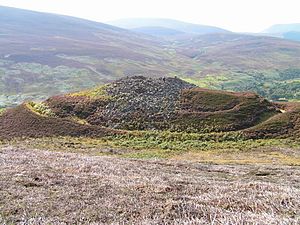
In the 1800s, people thought brochs were mainly for defense. They believed these towers were safe places for people and their animals during attacks. Some even thought they were built by the Danes or the Picts. From the 1930s to the 1960s, archaeologists like V. Gordon Childe saw them as castles. They thought local leaders lived in them and ruled over the people nearby.
However, this "castle theory" became less popular in the 1980s. This was because there wasn't enough archaeological proof to support it. Some archaeologists then suggested that defense wasn't the main reason for building brochs. They thought brochs might have been like the "stately homes" of their time. They could have been symbols of importance and wealth for powerful families. But again, there isn't much proof for this idea either. Also, there are so many brochs, sometimes in places without good farmland, which makes this theory less likely.
The way brochs are grouped together and how many there are might suggest they were indeed used for defense or even for attacking. Some brochs were built next to steep cliffs and had strong walls or natural barriers around them. A good example is at Burland in Shetland, which is on a clifftop with huge ditches protecting it.
Often, brochs are placed at important strategic points. In Shetland, they sometimes sit on opposite sides of narrow waterways. For example, the Broch of Mousa is directly across from another broch at Burraland. In Orkney, more than a dozen brochs are found on the shores of Eynhallow Sound. Many are also at the entrances and exits of the large harbor of Scapa Flow. In Sutherland, several brochs are located along the sides and mouths of deep valleys. Some experts believe that brochs in Shetland were forts built by a military group to watch over the land and sea.
Finally, some archaeologists think that each broch might have had a different purpose. They believe there wasn't just one reason for building every single broch. Brochs differ in their locations, sizes, and importance in different areas. For instance, the "broch villages" found in a few places in Orkney are not seen anywhere else.
How Brochs Were Built
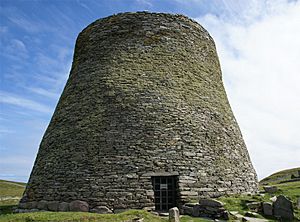
Brochs usually have one entrance with special features like bar-holes for locking the door and stone lintels (cross-beams) above the doorway. Inside the walls, there are small rooms called mural cells. There is also a ledge, called a scarcement, which might have supported wooden floors or roofs. Many brochs also have a spiral staircase winding up between the inner and outer walls, connecting different levels.
Brochs vary in size, from about 5 to 15 meters (16 to 49 feet) wide inside. Their walls are usually about 3 meters (10 feet) thick. Most broch walls today are only a few meters high. However, five brochs still have much taller walls, over 6.5 meters (21 feet) high. These include Dun Carloway on Lewis, Dun Telve and Dun Troddan in Glenelg, Mousa in Shetland, and Dun Dornaigil in Sutherland.
The walls of Mousa are the best preserved, still standing about 13 meters (43 feet) tall. It's not clear how many brochs were originally this high. A common feature of brochs is that their walls are hollow or "galleried." This means there's an open space between the outer and inner stone layers. These layers are held together by stone slabs. These slabs might have also served as steps to higher floors.
Near the entrance passage, there is often a small room called a guard cell. In some Shetland brochs, these guard cells are close to large stones that would have held the door. Although there was much debate in the past, many archaeologists now believe that brochs had roofs, possibly conical (cone-shaped) roofs made of timber and covered with thatch. However, there isn't much clear evidence for this. Finding enough wood for such roofs would have been a challenge, though bog wood and driftwood might have been used.
Very few brochs on the islands of Orkney and Shetland have rooms on the ground floor. Most brochs have ledges (scarcements) that suggest there was a wooden first floor. Excavations at Loch na Berie on the Isle of Lewis even show signs of a possible second floor. Some brochs, like Dun Dornaigil and Culswick in Shetland, have unusual triangular stones above their entrance doors.
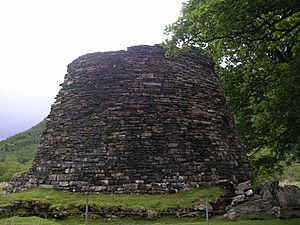
Brochs were often built near good farmland and a water source. Some even had wells or natural springs inside them. However, some brochs were built in wilder areas. Many brochs are located by the sea, like Carn Liath in Sutherland. Sometimes, they are on islands in lochs (lakes), such as Clickimin in Shetland.
About 20 broch sites in Orkney include small settlements of stone buildings around the main tower. Examples are Howe near Stromness, Gurness Broch in Orkney, Midhowe on Rousay, and Lingro near Kirkwall. These "broch villages" are also found in Caithness, but they are rare elsewhere.
Most brochs have not been fully dug up by archaeologists. The time when brochs were built seems to have ended around 100-200 AD. However, the ones that have been studied show that they were used for many centuries. Their insides were often changed and rebuilt, and they were lived in and left empty many times over the years.
Protecting Brochs
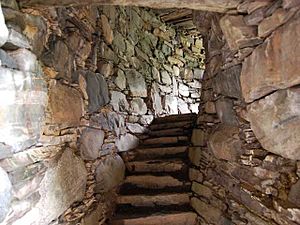
Some important broch sites in Shetland, like Mousa, Old Scatness, and Jarlshof, are on a special list. This list is for places that might be nominated as UNESCO World Heritage Sites. These are places considered to be very important for the world's cultural or natural history.
See also


